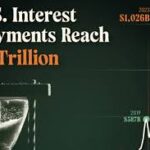In an unprecedented financial development, the U.S. government announced that it has spent over $1 trillion this year alone on interest payments for its staggering national debt, which now sits at $35.3 trillion. This marks a significant milestone in the ongoing conversation about national finances, raising serious questions about the sustainability of America’s fiscal policies.
The Growing Debt Crisis
The U.S. national debt has been ballooning for decades, driven by a combination of tax cuts, increased spending on social programs and defense, and, more recently, the economic impacts of the COVID-19 pandemic. While the country has been able to carry this debt burden relatively comfortably thanks to historically low interest rates, the Federal Reserve’s recent interest rate hikes have dramatically increased the cost of borrowing.
What once was manageable has now become a pressing financial challenge. Over $1 trillion in interest payments means that the government is spending a massive portion of its annual budget just servicing the debt—funds that could have been allocated to infrastructure, healthcare, or other vital services.
What Does This Mean for the Average American?
The rising cost of servicing the national debt could have far-reaching effects on American taxpayers and the broader economy. The more the government spends on interest payments, the less it has to invest in critical areas such as education, research, and public services. This dynamic can lead to either cuts in government programs or the necessity for additional borrowing, creating a vicious cycle.
Furthermore, if the government opts to raise taxes or reduce public spending to combat the deficit, Americans could see changes in their take-home pay and access to services. Inflation, already a concern, could be exacerbated as the government seeks new ways to balance the books.
The Political Angle
This issue has reignited debates in Washington about fiscal responsibility and the national debt ceiling. Some argue that the government should be more aggressive in reducing spending and implementing austerity measures. Others believe that the U.S. should focus on growing the economy and addressing systemic inequalities that have contributed to the debt.
The 2024 election cycle will likely see heated debates over how best to manage the national debt and interest payments. Candidates from both sides of the aisle are expected to propose a range of solutions, from targeted spending cuts to increased taxation of the wealthy.
What’s Next?
With interest payments already exceeding $1 trillion this year, the trend is expected to continue unless significant fiscal reforms are implemented. However, balancing the need for public services and economic growth with the imperative to reduce debt will be a complex challenge.
As the national debt continues to grow, it becomes clear that Americans are facing an era where fiscal policy could play a much larger role in daily life. Whether through higher taxes, cuts to public services, or increased borrowing, the cost of debt is something that can no longer be ignored.
ENG WANJIKU
Views: 0




